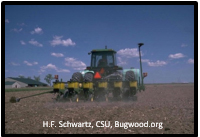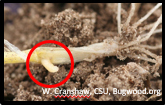
Fact Sheets And Publications
 Soil Insect Management in Field Corn
Soil Insect Management in Field Corn
Five major soil insects can be found in corn fields: seed corn maggot, white grubs, wireworms, cutworms and rootworms. Corn rootworm populations have increased in continuous corn production areas of New Castle and northern Kent counties. The occurrence of economic levels of soil insects depends on a number of factors including crop rotation, soil type, tillage, cover crops, and spring weather conditions. The decision to use a soil insecticide should be based on the knowledge of how these factors affect pest populations, pest history, and monitoring.
Sampling and Decision Making
White Grubs and Wireworms
| Species | Conditions Favoring Outbreaks | |
 |
Cutworms | Late planted corn; Combination of poorly drained soil, heavy broadleaf weed growth, soybean stubble, reduced tillage |
 |
Seed Corn Maggot | Cool and/or wet springs with delayed germination; Warm weather in late winter resulting in early fly emergence and egg laying before spring tillage; Early planting in fields with poor drainage, heavy crop residues, and/or manure applications |
 |
White Grubs | Planting into old sod, pasture, hay or set aside acreage; Planting into double crop or full season soybean stubble, especially fields with heavy grass infestations the previous season |
 |
Wireworms | High organic matter soils, sod covers, and heavy grass pressure the previous season; More prevalent in continuous corn with the above conditions. |
 |
Rootworms | Continuous corn planted on heavier soil types; Rotated corn planted on heavier soils following soybeans with heavy infestation of volunteer corn or weeds. |
White Grubs and Wireworms
| A. Sampling: |
| - Before planting when soil temperatures are 40 degrees F. at 6 inches deep. |
| - Before ground is tilled. |
| - At each site, sample one square foot of soil area dug six inches deep. |
| - Minimum of two samples must be taken for every 10 acres and no less than 10 samples per field. |
| B. Decision Making: |
| one white grub and/or wireworm per square foot |
Cutworms
| A. Sampling: |
| - Soil sampling is not effective. |
| - Preventative treatments should only be used in high risk fields. |
| - Examine 10 plants in 10 locations for small irregular holes in leaves and/or wilted and cut plants. |
| - Begin scouting at plant emergence and continue through the 5 leaf stage. |
| - Check for the presence of larvae and determine the average size. |
| B. Decision Making: |
| -1-2 leaf stage: 3% cut plants or 10% leaf feeding damage |
| - 3-4 leaf stage: 5% cut and larvae present (generally less than one inch long) |
Rootworms
| A. Sampling: |
| - Conventionally tilled continuous corn can be scouted for rootworm larvae before lay-by and a soil insecticide applied at cultivation. Examine the roots and soil around 10 plants in 10 locations for the presence of larvae. |
| - The decision to use an at-planting insecticide is based on the previous year’s adult populations. If corn is rotated with other annual crops, a rootworm insecticide is generally not needed. Continuous corn fields should be monitored 3-4 times from late July to mid-August to determine the number of egg- laying adults per plant. The best indicator of potential problems for the following year will occur if sampling begins after females begin laying eggs (10% gravid females). Examine 10 plants in five locations and count the number of Northern and Western Corn Rootworm adults per plant. Divide the number of northern beetles by two and add to the number of westerns to determine the average number per plant. Yellow sticky traps used at a density of one trap for every 5 acres placed in the ear zone area can also be used to monitor adult beetles. |
| B. Decision Making: |
| (a) Rotation when possible |
| (b) Cultivation Treatment: 2-3 larvae per plant |
| (c) Adult Counts to Decide on Soil Insecticide Use the Following Year: |
| - Second and Third Year Corn Fields: 0.25 beetles per plant or 10 beetles per week per yellow sticky trap |
| - Continuous Corn 4 or More Years: 1-2 adults per plant or 35 beetles per week per yellow sticky trap |
Chemical Control Options
In general, no one soil insecticide will provide control of all potential soil insect pests. Field history, knowledge of conditions favoring a pest outbreak and proper sampling should be used to make a treatment decision. Also remember the label is the law so be sure to read all pesticide labels before making an application for use directions and restrictions
UD Cooperative Extension
This institution is an equal opportunity provider.
In accordance with Federal law and U.S. Department of Agriculture policy, Cooperative Extension is prohibited from discriminating on the basis of race, color, national origin, sex, age, or disability.
